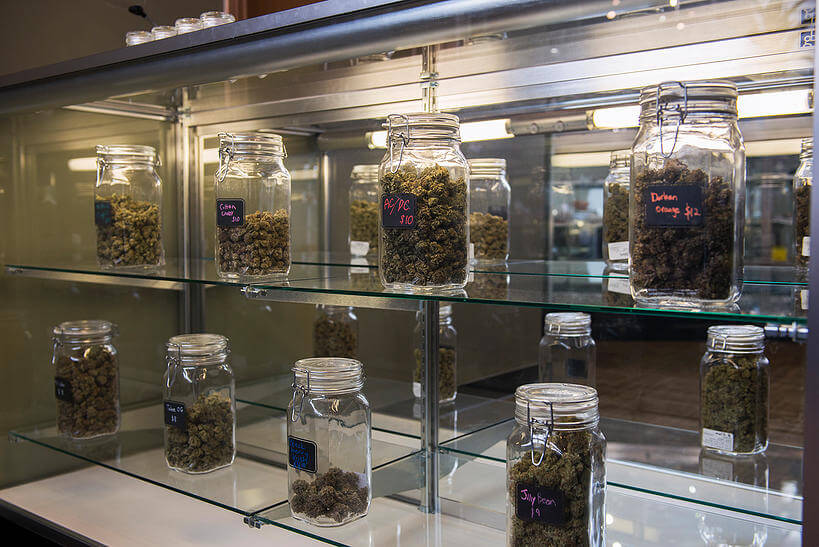Aug 30, 2015 | Marijuana Legalization, MMJ News
Revenue from legalized marijuana in Colorado for the first half of 2015 is almost twice the same period from a year ago. This is great news for the state and may be good news for taxpayers as well. According to Colorado’s Taxpayer’s Bill of Rights (TABOR), any revenue that is collected beyond projections results in prorated refunds.
Though marijuana continues to be classified as a controlled substance for federal purposes, four states, including Colorado, have legalized recreational use with firm rules around its distribution and use. The businesses involved in the marijuana industry are also highly taxed for the privilege of entering this lucrative new market, and filing a federal income tax return is basically confessing to breaking federal law.
Despite these complications, many people have rushed to enter the industry. Colorado has the tax revenue’s to prove it, with $44 million pouring into the coffers in the first 5 months of 2015. The people paying all those taxes may have reason to be happy as well. With TABOR in place, refunds begin if marijuana tax revenues exceed $58 million for the year.
(more…)
Aug 17, 2015 | California Marijuana Laws, Proposed MMJ Law Changes
Don Duncan at Americans for Safe Access recently published an article outlining the benefits of MMJ regulations in California. He feels that research and experience show that sensible regulations are good for MMJ patients, providers, and CA communities.
The California State Legislature will be back in session soon and there are currently three medical cannabis bills that the Senate Appropriations Committee will be considering. The bills specifically cover licensing and regulation of commercial medical cannabis activity and to toughen laws related to manufacturing concentrated cannabis. [AB 243 (Wood), AB 266 (Bonta), and AB 849 (Bonilla)].
Medical marijuana regulations will help set the stage if there is legalization in California November 2016. Some of the benefits of commercial medical cannabis regulations are:
(more…)

Aug 12, 2015 | Marijuana Legalization, Proposed MMJ Law Changes
YES, Recreational usage of marijuana became legal in CA with the passing of Proposition 64 (AUMA) on Nov 8th, 2016 (by a majority vote of 56%). The law took effective immediately and allows individuals to possess and grow (a limited amount of marijuana). Medical marijuana has been legal in California since 1996.
Adult Use of Marijuana Act
Controls, regulates, and taxes responsible adult use of marijuana, while protecting children, safeguarding local control, protecting public health and public safety, and defending our environment and water.
Prop 64 allows adults age 21+ to possess, transport, purchase, recreationally consume and share up to one ounce of marijuana and eight grams of marijuana concentrates.
– You can legally grow up to six plants at home
– Smoking marijuana in public is still illegal.
– Driving while under the influence of marijuana is still illegal.
Imposes a 15% excise tax on all marijuana sales.
– The independent Legislative Analyst’s Office (LAO) expects annual revenue to eventually reach over $1 billion.
– Projected to save the state and local governments $100 million annually due to reduced legal and incarceration costs.
Directs tax revenues to the newly established California Marijuana Tax Fund.
– 60% of the fund will be used towards youth substance abuse prevention, treatment, and education.
– 20% goes to helping state and local law enforcement.
– 20% will be used for environmental purposes, restoration, cleanup, and enforcement efforts.
– Additionally, a portion of revenue will be allocated for medical marijuana research and to studying implementation outcomes.
– Creates a community reinvestment fund that will allocate tens of millions of dollars annually towards economic development and job placement for neighborhoods most in need.
– A portion of revenue will also be used for medical marijuana research and for studying implementation outcomes.
Greatly reduces – and in many cases, eliminates – criminal penalties for marijuana offenses.
– Alleviates the currently overburdened criminal justice system.
– Allows those with prior marijuana convictions to petition the courts to revisit cases that the new law legalizes.
Imposes the strictest regulations governing labeling, packaging and testing of marijuana products in the nation. These are designed to protect children from accessing marijuana, and to convey warnings to help adults consume safely.
-The Department of Consumer Affairs (DCA) will serve as the lead regulatory agency.
-The Department of Public Health (DPH) will oversee testing and manufacturing.
-The Department of Food & Agriculture (DFA) will oversee cultivation.
Favors small scale producers and keeps large corporations from gaining a monopoly.
– Prop 64 allows marijuana to be sold by state-licensed businesses, and it gives the state until Jan. 1st, 2018, to begin issuing licenses for retailers.
– Delays issuance of large cultivation licenses for the first five years that AUMA is in effect allowing smaller growers to establish themselves in the market.
– Restricts large producers from vertically integrating with each other.
Legalizes industrial hemp production.
– Will add millions of dollars to the California economy and create new jobs.
– Hemp products have an astonishing number of useful applications as well as a net environmental benefit.
Allows local communities to still impose power.
– Towns can ban commercial growing and retail sales but not possession or consumption.
Thanks to Sean Parker, George Soros, Gavin Newsom and hundreds of other volunteers/supporters who put effort into passing this bill.

Aug 12, 2015 | Marijuana Legalization

Aug 12, 2015 | Marijuana Legalization
In the last ten years we have seen the Federal Government’s view on medical marijuana evolve.
In 2000 President George W. Bush campaigned that he would let states make decisions about medical marijuana, saying “I believe each state can choose that decision as they so choose.” The number of dispensaries increased throughout his term in office. However during this period the DEA continued to raid dispensaries often without the assistance from local law enforcement. This was not the ideal situation for medical marijuana providers – Federal minimum sentencing was still in full effect and a guilty conviction in Federal court would mean a stiff prison sentence.
Obama Administration – Change? Think again. (March 2009)
In March of 2009, after President Obama took office, federal Attorney General Eric H. Holder Jr. said the current administration was taking a new approach to federal drug laws and would end the frequent raids on distributors of medical marijuana that were commonplace during the Bush administration. Specifically, “Given the limited resources that we have, our focus will be on people, organizations that are growing, cultivating substantial amounts of marijuana and doing so in a way that’s inconsistent with federal and state law.” Everyone in the medical marijuana industry felt this was a giant win. Finally, providers and patients could breathe easy, for a little while, at least.
Prop 19 (November 2010)
On Nov 2nd 2010 Californians voted on the legalization of marijuana for recreational use. U.S. Attorney General Eric Holder threatened to “vigorously enforce” federal marijuana laws even if California voters approved the ballot measure. In a letter to former Drug Enforcement Administration officials, Holder stated that Bottom of Form“the Department of Justice strongly opposes Proposition 19.” And if passed, he said, it “would provide a significant impediment to … efforts by law enforcement to target drug traffickers who frequently distribute marijuana alongside cocaine and other controlled substances.”
Unfortunately, Proposition 19 lost 46.2% to 53.8%, but that showed that a substantial number of Californians want change and feel that there are many positives that would come from legalization. Our fingers are crossed that a modified proposition for legalization will pass in the near future.
Federal Prosecutors Attack Property Owners (October 2011)
In early October, 2011, the federal government did an about-face. At a news conference in Sacramento, Andre Birotte Jr., the Los Angeles-based U.S. attorney for the Central District, stated that (his) Southern California region is home to the highest concentration of dispensaries in the nation. “We have yet to find a single instance in which a marijuana store was able to prove that it was a not-for-profit organization,” he said.
“That is not what the California voters intended or authorized, and it is illegal under federal law,” he said. “It does not allow this brick-and-mortar, Costco-Walmart-type model that we see across California.”
California’s four federal prosecutors also sent a number of letters to the property owners of these dispensaries, giving them two weeks to shut down. This same tactic was used by the Bush administration to successfully close a number of dispensaries in 2007. The feds can legally seize these properties through civil forfeiture if push comes to shove. According to the letters signed by U.S. Attorney Laura Duffy in San Diego, “Real and personal property involved in such operations are subject to seizure by and forfeiture to the United States … regardless of the purported purpose of the dispensary.” Luckily, most of the recently sent letters were nothing more than empty threats.
Federal Government Closes Down Dispensaries and Threatens To Seize Property (April 2012)
In April 2012, the DEA raided and shut down Oaksterdam University, the main medical cannabis industry trade school that was founded by Richard Lee in Oakland, California. A number of dispensaries and grow facilities were also raided in Southern California around that time. In early May of 2012, federal agents raided two dispensaries in Santa Barbara and issued cease and desist letters to the ten remaining dispensaries in town. These dispensaries were given two weeks to shut down or face criminal prosecution and the loss of property. The federal government stopped making threats and is attacking the marijuana industry at a previously unseen level.
According to Americans for Safe Access, since the Obama administration has been in office, they have unleashed an interagency cannabis crackdown that goes beyond anything seen under the Bush administration, with more than 100 raids, primarily on California pot dispensaries, many of them operating in full compliance with state laws. Since October 2009, the Justice Department has conducted more than 170 aggressive SWAT-style raids in medical marijuana states, resulting in at least close to a hundred federal indictments.
Voter Approved initiatives in Colorado and Washington to Legalize marijuana (November 2012)
Colorado passed Proposition 64 and Washington passed Initiative 502 making it legal for anyone over the age of 21 to possess marijuana and for businesses to sell it. This took some pressure off the California medical marijuana as the Feds had a bigger problem to deal with. The federal government was adamantly opposed to these initiatives and stated they would continue to enforce Federal marijuana laws. This feds were put in a difficult position and something had to give.
In August of 2013 the Justice Department issued a statement saying it won’t challenge state laws that legalize marijuana and will focus federal enforcement on serious trafficking cases and keeping the drug away from children. The US Attorney General notified the governors of Colorado and Washington and said they will not seek to pre-empt those states’ laws allowing recreational marijuana use.
Federal prosecutors were directed to refocus on eight enforcement priorities, including preventing marijuana distribution to minors, preventing drugged driving, stopping drug trafficking by gangs and cartels and forbidding the cultivation of marijuana on public lands.
For entities operating in the marijuana business, the government expects “robust controls and procedures that are effective in practice (not just on paper). The size and profitability of these businesses will still be a factor prosecutors can consider, but there also must be additional illegal activities for prosecutors to take action.
Current Situation
With the recent legalizations in Colorado, Washington and now Oregon we are entering unchartered territory for marijuana industry and it is a great time to be a part of it. The federal government appears to be backing off a bit. In a January 2014 article in the New Yorker magazine President Obama stated that he didn’t “think (marijuana) was more dangerous than alcohol.” A few days later the deputy director of the White House’s Office of National Drug Control Policy, Michael Botticelli, reluctantly agreed.
So it looks like the pendulum might be swinging back in our favor and medical marijuana (and marijuana in general) is gaining more mainstream acceptance. However you still need to stay vigilant as the Feds have said one thing and done another too many times in the past. There are still many years and milestones ahead for a national legalization. Keep in mind local police departments have their own agendas and can create just as many problems for you. Stay apprehensive, don’t take anything for granted and keep yourself out of trouble.
(December 2014)bipartisan Rohrabacher-Farr amendment which prevents the federal government from using funds to arrest and prosecute medical marijuana patients or distributors who are in compliance with their state’s laws. Some argue that this bill wasn’t written very clearly and leave some loop holes for the DEA to exploit. This was suppose to be a message from the House to back off legitimate medical marijuana providers.

Aug 11, 2015 | Marijuana Legalization
[as-accordion autoclose=”false” openfirst=”false” clicktoclose=”true” tag=”h4″]
[as-accordion-item title=”1. Create a (not-for-profit) business plan or outline of what you want to accomplish”]
- Determine your goals and specific features that will help you accomplish them
- Decide between a storefront dispensary or mobile MMJ delivery service (or combination of the two)
- Find a mentor to help make a game plan and can help you along the way
- Partner with qualified trustworthy individuals
[/as-accordion-item]
[as-accordion-item title=”2. Read and understand CA MMJ Laws and local regulations”]
- Senate Bill 215 or The Compassionate Use Act of 1996
- California Proposition 420 – The Medical Marijuana Program Act
- 2008 California Attorney General’s Guidelines for “The Security and Non-Diversion of Marijuana Grown for Medical Use”
[/as-accordion-item]
[as-accordion-item title=”3. Determine where you will operate”]
- Many cities/counties add their own unique laws with regard to medical marijuana “business”
- A list of California local regulations
http://www.safeaccessnow.org/california_local_regulations - Some cities have banned MMJ dispensaries
- You will have to weigh the pros and cons of working in an area with a lot of competition (as there are a number of MMJ dispensaries or delivery services) versus venturing into an area where the politics are less accepting.
[/as-accordion-item]
[as-accordion-item title=”4. Obtain your doctors recommendation to use medical marijuana.”]
- Under Prop 215 individuals may use marijuana to treat “cancer, anorexia, AIDS, chronic pain, spasticity, glaucoma, arthritis, migraine headaches , or any other illness for which marijuana provides relief.” It is the last one that allows doctors almost unlimited possibilities to prescribe this herb.
- A doctor’s recommendation to use MMJ exempts qualified patients from criminal liability for possessing or cultivating marijuana when these conducted pursuant to the recommendation.
- Doctor’s recommendations typically need to be updated annually
[/as-accordion-item]
[as-accordion-item title=”5. Speak with a qualified MMJ attorney in the local area that you will be operating.”]
- As you have likely found through your research, there is more than one way to operate a legally under CA law. Ask the attorney how they would start a medical marijuana dispensary. The local law enforcement might have their opinions on how a “legal” operation should be set up. Do whatever you can to become compliant in their eyes. This is where a respected MMJ attorney is worth every penny.
- If nothing else have an attorney’s name and number that you will call in case of emergency. You don’t want to be scrambling to find someone in the heat of the moment.
[/as-accordion-item]
[as-accordion-item title=”6. Determine what entity will best suit your plan”]
- There isn’t one right answer for how to set up your MMJ entity. It is required that the entity function as a “not-for-profit” similar to how typical non-profit entities operate.
- Senate Bill 420 authorized patient “cooperatives” or “collectives” to grow, distribute and/or sell medical marijuana on a non-profit basis to their members.
- From the less involved articles of association to incorporating as a Mutual Benefit not-for-profit corporation.
- Cooperative or “co-ops”
[/as-accordion-item]
[as-accordion-item title=”7. Obtain a Sellers Permit from the Board of Equalization (BOE)”]
- Unfortunately medical marijuana is taxable and the CA BOE issued a memo regarding this matter. It is just not worth trying to take an alternative approach on this one. At the current base rate of 7.5% you don’t want to be playing catch up or get hit with a bill for back owed tax. This could be detrimental to the organization and you in general
[/as-accordion-item]
[as-accordion-item title=”8. Seek like minded members of for your organization”]
- Use professional, adult focused, advertising methods
- Use discretion based on your location
- Seek word of mouth referrals
[/as-accordion-item]
[as-accordion-item title=”9. Get patients/members to join your organization”]
- Verify that members are eligible under CA law to use medical marijuana/ join a Collective
- Are they a California Resident
- Do they have a current Doctor’s Recommendation
- Verify CA ID matches the name on the recommendation
- Call the doctors office to verify the recommendation is valid
- Have individuals sign a Collective Membership Agreement
- Identify the current state and local laws the individual must follow along with additional guidelines set up by the organization
- The agreement will ensure that the medical marijuana purchased is for the individuals use and that they will not divert the medicine to others or resell.
- Make sure individuals understand the agreement they are signing and what is expected of them.
- Make it clear that they can be removed from the organization for violating its policies.
- Keep a copy of the members ID, recommendation and signed Collective agreement
[/as-accordion-item]
[as-accordion-item title=”10. Keep detailed records of expenses and purchases.”]
- MMJ businesses will be looked at with extra scrutiny given the nature of the product and that they deal with a lot of cash. Keep accurate, easy to follow, up to date records. This will help you keep a finger on the pulse of the business and also be prepared for inquiries as they arise from various agencies.
- As the founder of the collective you are entitled to reasonable compensation for your time and effort. Keep in mind profits are not allowed. Any earnings left after all expenses have been paid should be returned to the member or used to benefit the group as a whole.
- Pay all sales taxes, Employer (EDD) payroll taxes (if applicable), IRS Federal taxes and CA FTB state income taxes
[/as-accordion-item]
[as-accordion-item title=’11. Develop a “What if” emergency plan and be prepared.’][/as-accordion-item]
[/as-accordion]
Aug 7, 2015 | California Marijuana Laws, MMJ News
Medical marijuana businesses are now allowed to pay sales tax with cash since most banks won’t provide services to them. The BOE is hoping to bring “underground sellers” out of the shadows as well as individuals starting medical marijuana businesses. The BOE is also allowing these medical marijuana businesses to use a DBA (Doing Business As), and accept personal checks as payment for the business tax liability.
Medical cannabis businesses are required to pay sales taxes to the Board of Equalization in California. In the past there were a number of businesses that did not collect or pay sales tax. Some collectives argue they don’t owe taxes while other just don’t pay the. The BOE came out with a memo specifically addressing this issue in 2007. Prior to 2005 the BOE would not issue a resellers permit for the sale of illegal substances.
(more…)
Jul 17, 2015 | Marijuana Legalization, MMJ News
The debate on the legalization of marijuana and its medical uses has been a raging topic for quite some time in the U.S. As of now, 23 states in the U.S. have legalized the application of marijuana for medicinal use. Many studies that have been carried out have shown that marijuana can be used in certain circumstances to treat different physical and mental medical conditions but the effect of this medicinal use and its contribution to a cure could very much depend on the specific medical condition.
Broadly speaking, for medical conditions like nausea and vomiting that AIDS patients and cancer patients experience, for nerve pain, multiple sclerosis and general chronic pain, treatment incorporating marijuana has shown substantial promise. With regard to serious illnesses like epilepsy, Crohn’s disease, cancer and Parkinson’s disease, research undertaken has shown that treatment involving medicinal marijuana could be significantly effective. However, the positive contribution of medicinal marijuana is limited for the effective treatment of medical conditions like Alzheimer’s disease, Anxiety disorders, Post-Traumatic Stress Disorders, Weight Loss, Lupus and Glaucoma, based on the research undertaken as of now.
(more…)
Jul 14, 2015 | Collective Operations
Reasonable compensation is not defined by numbers but can vary greatly depending on the experience of the individual, the number of people served, the hours worked and what people are being paid in a similar position (whether that be in MMJ industry or another non-profit setting). A highly educated individual who has given up a high paying job to purse a career in medical marijuana has a better chance justifying a high compensation package than someone with little real world experience (and no prior earning records).
Most California dispensaries are set up as a form of not-for-profit corporation or coop as opposed to a traditional 501c(3) nonprofit. However, we can look to the nonprofit arena for compensation guidelines – theses entities are in parallel to how a proper California medical marijuana dispensary should be run.
(more…)
Jul 6, 2015 | California Marijuana Laws, Proposed MMJ Law Changes
California was the first state to legalize medical marijuana. However, recreational use of marijuana is still illegal. The medical marijuana programme was first passed by the California state as Proposition 215 in 1996 and as a Senate bill 420 in 2003. Prop.215 also known as the Compassionate Use Act allowed people with Cancer, AIDS and other chronic illnesses to grow or obtain marijuana for medical purposes when recommended by a doctor. This was voted into action with a 55% majority.
The Medical Marijuana Protection Act or SB 420 signed into existence by Governer Gray Davis intents to establish an identification card system for medical marijuana patients. Currently Medical Marijuana users in California with a valid Doctors recommendation may grow and possess as much marijuana as they require, provided it is strictly for personal use.
(more…)




